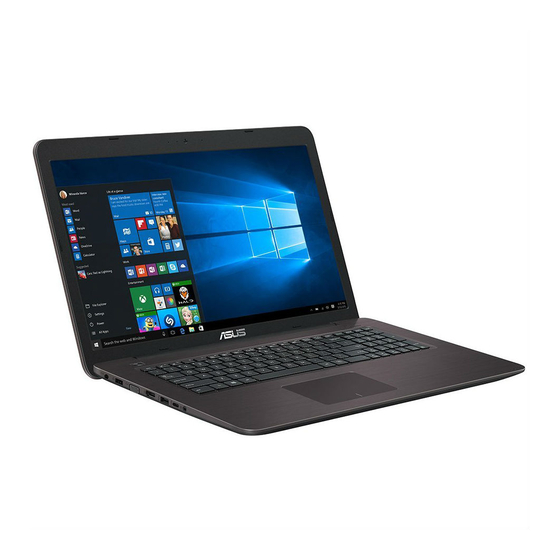
Table of Contents
Advertisement
Advertisement
Table of Contents

Summarization of Contents
About this manual
Conventions used in this manual
Explains text conventions, icons, and typography used in the manual.
Chapter 1: Hardware Setup
Getting to know your Notebook PC
Introduces the physical components of the notebook PC.
Top View Components
Details components visible from the top of the notebook.
Bottom View Components
Details components located on the bottom of the notebook.
Right Side Ports
Details components on the right side of the notebook.
Left Side Ports
Details components on the left side of the notebook.
Front Side Indicators
Details components on the front side of the notebook.
Chapter 2: Using your Notebook PC
Getting started and basic operations
Guides on initial setup and basic operations of the notebook.
Charge your Notebook PC
Instructions for charging the notebook's battery.
Lift to open the display panel
Explains how to open the notebook's display.
Press the power button
Details how to turn the notebook on/off and manage sleep modes.
Using the touchpad
Explains touchpad gestures and navigation.
Using the keyboard
Covers keyboard functions, including special keys.
Function keys
Details the specific functions of the F1-F12 keys.
Windows® 10 keys
Explains the function of Windows-specific keys.
Multimedia control keys
Describes keys used for media playback control.
Using the numeric keypad
Explains the use of the numeric keypad for input and navigation.
Using the optical drive
Instructions for using the notebook's optical drive.
Chapter 3: Working with Windows® 10
Starting for the first time
Guides through the initial Windows 10 setup process.
Start menu
Explains the Windows 10 Start menu and its functionalities.
Windows® apps
Describes Windows apps and their tiled display.
Working with Windows® apps
Covers launching, customizing, and managing Windows apps.
Task view
Explains the Task view feature for switching between apps and desktops.
Snap feature
Describes how to arrange apps side-by-side using Snap.
Action Center
Explains the Action Center for notifications and quick actions.
Other keyboard shortcuts
Lists useful keyboard shortcuts for navigation and launching apps.
Connecting to wireless networks
Guides on connecting to Wi-Fi and Bluetooth networks.
Connecting to wired networks
Guides on connecting to wired networks via LAN.
Turning your Notebook PC off
Procedures for shutting down the notebook.
Putting your Notebook PC to sleep
Instructions for putting the notebook into sleep mode.
Chapter 4: Power-On Self-Test (POST)
Using POST to Access BIOS
Learn how to access BIOS settings and troubleshooting options during POST.
BIOS Settings Overview
Details general BIOS configuration options.
Boot Options Configuration
How to configure boot priorities in BIOS.
Security Settings Management
Managing BIOS security features like passwords.
I/O and USB Interface Security
Configuring security for interfaces like I/O and USB.
Master Password Setup
Instructions for setting an HDD master password.
Saving and Exiting BIOS
Procedures for saving BIOS changes and exiting.
Updating the BIOS
Step-by-step guide to update the notebook's BIOS.
System Recovery Options
Explains how to restore the system to its original state.
Performing a Recovery
Step-by-step guide to execute system recovery.
Chapter 5: Upgrading your Notebook PC
Removing the compartment cover
Instructions for removing the notebook's compartment cover.
Installing a RAM module
Guide on how to install a RAM module.
Tips and FAQs
Useful tips for your Notebook PC
Provides general tips for maximizing notebook usage and performance.
Hardware FAQs
Answers common questions about notebook hardware issues.
Software FAQs
Answers common questions about notebook software issues.
Appendices
DVD-ROM Drive Information
Information about the DVD-ROM drive capabilities.
Regional Playback Information
Explains regional restrictions for DVD playback.
Blu-ray ROM Drive Information
Information about the Blu-ray ROM drive capabilities.
Internal Modem Compliancy
Details on the notebook's internal modem compliance.
Network Compatibility Declaration
Statement regarding network compatibility.
Declaration of Conformity (R&TTE directive 1999/5/EC)
EU declaration of conformity for R&TTE directive.
Federal Communications Commission Interference Statement
FCC statement on interference compliance.
FCC Radio Frequency (RF) Exposure Caution Statement
FCC statement on RF exposure.
CE Marking
Information regarding CE marking for compliance.
IC Radiation Exposure Statement for Canada
IC statement on radiation exposure for Canada.
Wireless Operation Channel for Different Domains
Channels used for wireless operations in different regions.
France Restricted Wireless Frequency Bands
Information on restricted wireless frequency bands in France.
UL Safety Notices
Safety precautions related to UL standards.
Power Safety Requirement
Requirements for power cords and safety.
Prevention of Hearing Loss
Advice on preventing hearing damage from loud audio.
Nordic Lithium Cautions (for lithium-ion batteries)
Safety cautions for lithium-ion batteries.
Optical Drive Safety Information
Safety information related to the optical drive laser.
CDRH Regulations
Regulations for laser products.
Coating Notice
Notes on device coating for electrical safety.
CTR 21 Approval (for Notebook PC with built-in Modem)
Approval details for the built-in modem.
ENERGY STAR Complied Product
Information on ENERGY STAR compliance.
Global Environmental Regulation Compliance and Declaration
Details on environmental compliance and declarations.
ASUS Recycling/Takeback Services
Information on ASUS recycling and takeback programs.
Regional notice for California
Specific notice for California regarding product chemicals.
Regional notice for India
Specific notice for India regarding e-waste regulations.
Notices for removable batteries
Important notices regarding removable batteries.
EC Declaration of Conformity
EU declaration of conformity for the product.

Need help?
Do you have a question about the R753U and is the answer not in the manual?
Questions and answers